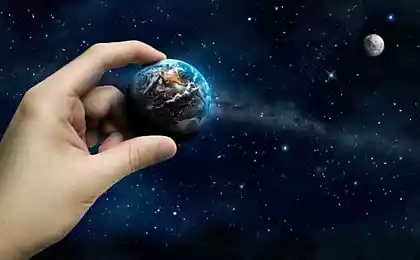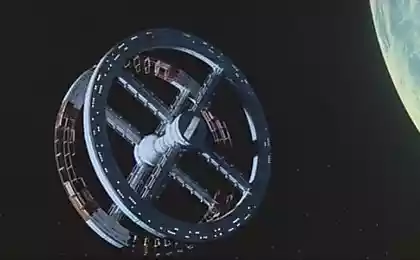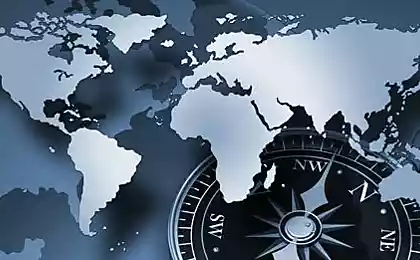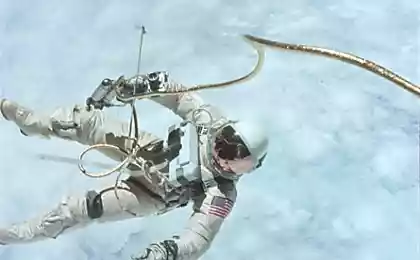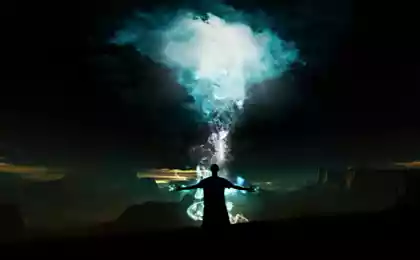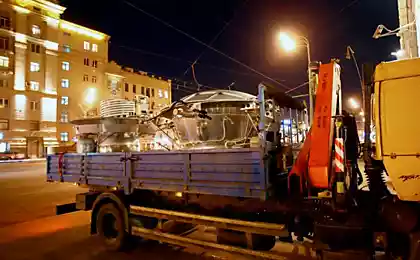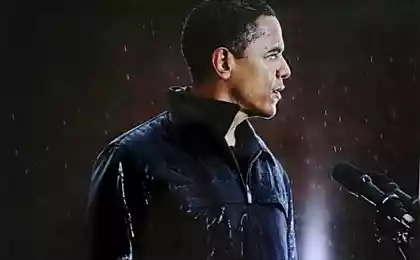878
Space pioneers (11 photos)
Day of Astronautics devoted to!
Before you send a man into space, the space agencies of the Soviet Union and the United States sent
in short flights of animals. In January, 1961. chimpanzee Ham (Ham) went into space from the base at Cape Canaveral.
On Earth, he returned unharmed, but a great desire to go back in one flight he did not have.

At the beginning of the 1960s. The Soviet Union knew that America is planning to launch an astronaut, but did not know when. Chief Scientist in space USSR Sergei Korolev achieved start with the human crew of the ship as soon as possible. Yuri Gagarin flew along the Earth's orbit in April 1961., Ahead of the United States less than a month.
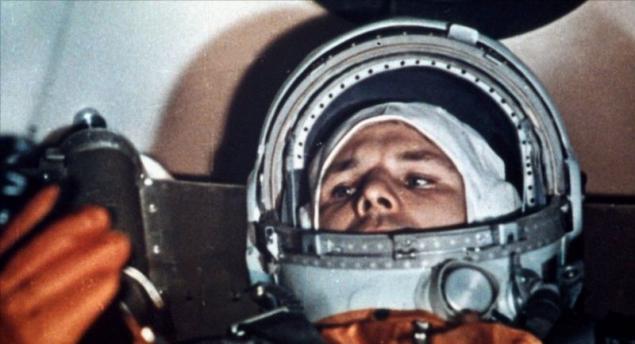
The main developer of rockets NASA Wernher von Braun (Wernher von Braun) (left) and astronaut team "Mercury 7" Gordon Cooper (Gordon Cooper) (right) photographed during the operation to return control of the first American to visit space, Alan Shepard (Alan Shepard ), whose capsule "Freedom 7", as scheduled, it drives in the Atlantic Ocean after a 15-minute suborbital flight in May 1961.

General Secretary of the Soviet Union, Nikita Khrushchev (Nikita Khrushchev) holds hands Valentina Tereshkova (Valentina Tereshkova), the first female astronaut, and Valery Bukovsky (Valery Bykovsky), set the record for time spent in space. Khrushchev (Khrushchev) was extremely knowledgeable about the value of propaganda successes in space.
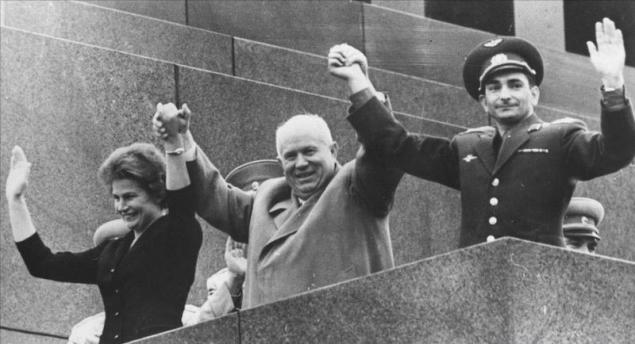
Astronaut John Glenn (John Glenn) looks calm while relaxing aboard the USS Noa after the historic flight aboard the capsule "Mercury-Atlas 6". In February, 1962. Glenn (Glenn) circled the globe four times during the flight, which lasted about 5 hours. Noah took his ship after landing in the Atlantic Ocean near the island of Grand Turks.
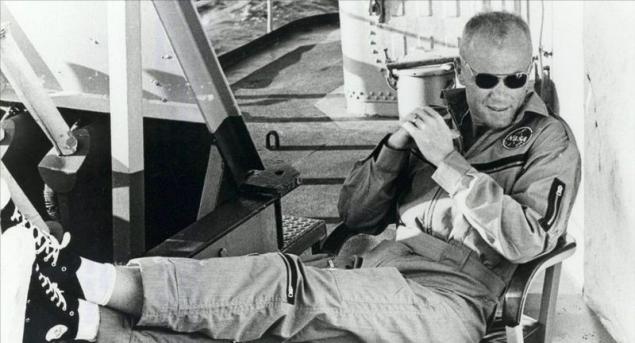
In March, 1965. Cosmonaut Alexei Leonov again pushed the Soviet Union in the first place, having made the first spacewalk. During a 12-minute walk Leonov suit inflated, preventing them from getting back to the spaceship. With valve astronaut released excess air from the suit and saved his life.
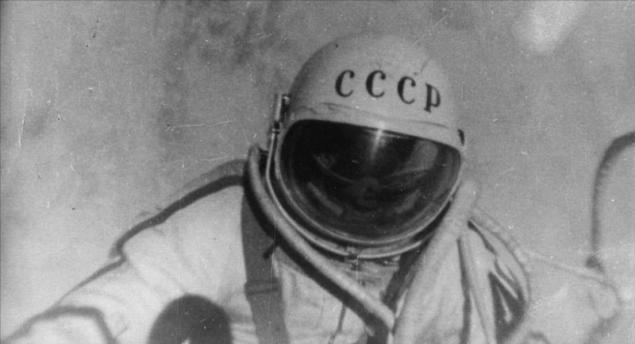
By the mid-1960s. The US is still planning to catch up with the Soviet Union. In June, 1965. NASA astronaut Ed White (Ed White) (pictured) became the first American to walk in space, about 3 months after Leonov. Spare thermal glove became part of space debris floating away from the White (White).

Astronauts Gus Grissom (Gus Grissom) (left) and John Young (John Young) (right) train to get out of the Gemini spacecraft after landing in the ocean after completion of the mission. This picture was taken in 1965. during a training session in the pool at the base of Ellington Air, Texas.
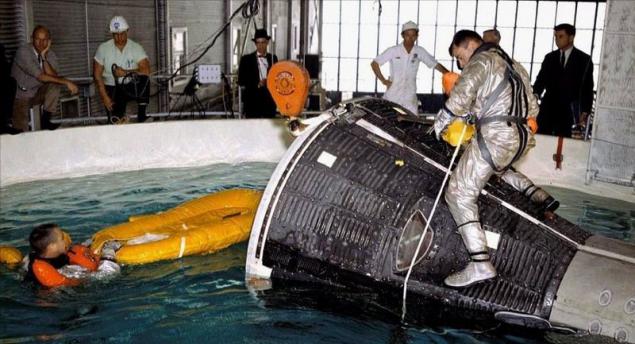
Spaceships Gemini 6 and 7 were launched at the same time to perform the first manned docking of ships in space. Ships operated by Thomas Stafford (Thomas Stafford) and Walter Schirra (Walter Schirra) closer to a distance of 30cm during maneuvers in space.

Spaceships Gemini 6 and 7 were launched at the same time to perform the first manned docking of ships in space. Ships operated by Thomas Stafford (Thomas Stafford) and Walter Schirra (Walter Schirra) closer to a distance of 30cm during maneuvers in space.
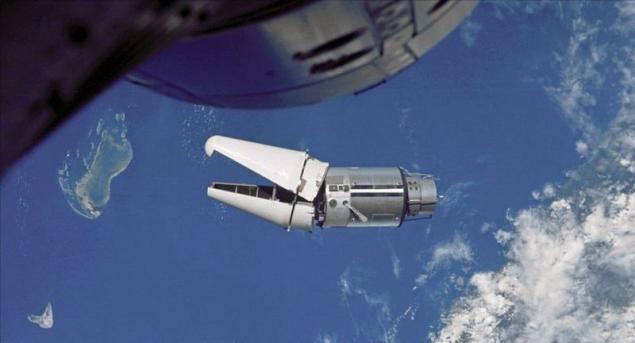
Lessons learned during the missions Mercury and Gemini were necessary for the successful implementation of the lunar program of NASA. In the picture 1964. illustrated lunar landing research aircraft tested at a military base in California's Edwards Air.
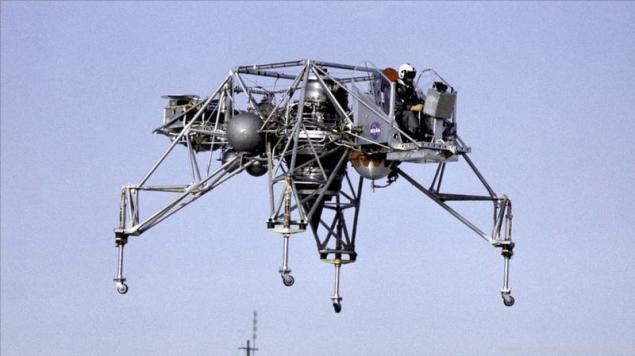
Before you send a man into space, the space agencies of the Soviet Union and the United States sent
in short flights of animals. In January, 1961. chimpanzee Ham (Ham) went into space from the base at Cape Canaveral.
On Earth, he returned unharmed, but a great desire to go back in one flight he did not have.

At the beginning of the 1960s. The Soviet Union knew that America is planning to launch an astronaut, but did not know when. Chief Scientist in space USSR Sergei Korolev achieved start with the human crew of the ship as soon as possible. Yuri Gagarin flew along the Earth's orbit in April 1961., Ahead of the United States less than a month.

The main developer of rockets NASA Wernher von Braun (Wernher von Braun) (left) and astronaut team "Mercury 7" Gordon Cooper (Gordon Cooper) (right) photographed during the operation to return control of the first American to visit space, Alan Shepard (Alan Shepard ), whose capsule "Freedom 7", as scheduled, it drives in the Atlantic Ocean after a 15-minute suborbital flight in May 1961.

General Secretary of the Soviet Union, Nikita Khrushchev (Nikita Khrushchev) holds hands Valentina Tereshkova (Valentina Tereshkova), the first female astronaut, and Valery Bukovsky (Valery Bykovsky), set the record for time spent in space. Khrushchev (Khrushchev) was extremely knowledgeable about the value of propaganda successes in space.

Astronaut John Glenn (John Glenn) looks calm while relaxing aboard the USS Noa after the historic flight aboard the capsule "Mercury-Atlas 6". In February, 1962. Glenn (Glenn) circled the globe four times during the flight, which lasted about 5 hours. Noah took his ship after landing in the Atlantic Ocean near the island of Grand Turks.

In March, 1965. Cosmonaut Alexei Leonov again pushed the Soviet Union in the first place, having made the first spacewalk. During a 12-minute walk Leonov suit inflated, preventing them from getting back to the spaceship. With valve astronaut released excess air from the suit and saved his life.

By the mid-1960s. The US is still planning to catch up with the Soviet Union. In June, 1965. NASA astronaut Ed White (Ed White) (pictured) became the first American to walk in space, about 3 months after Leonov. Spare thermal glove became part of space debris floating away from the White (White).

Astronauts Gus Grissom (Gus Grissom) (left) and John Young (John Young) (right) train to get out of the Gemini spacecraft after landing in the ocean after completion of the mission. This picture was taken in 1965. during a training session in the pool at the base of Ellington Air, Texas.

Spaceships Gemini 6 and 7 were launched at the same time to perform the first manned docking of ships in space. Ships operated by Thomas Stafford (Thomas Stafford) and Walter Schirra (Walter Schirra) closer to a distance of 30cm during maneuvers in space.

Spaceships Gemini 6 and 7 were launched at the same time to perform the first manned docking of ships in space. Ships operated by Thomas Stafford (Thomas Stafford) and Walter Schirra (Walter Schirra) closer to a distance of 30cm during maneuvers in space.

Lessons learned during the missions Mercury and Gemini were necessary for the successful implementation of the lunar program of NASA. In the picture 1964. illustrated lunar landing research aircraft tested at a military base in California's Edwards Air.

